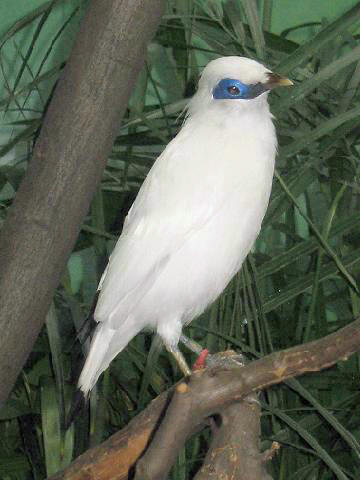- Bali Starling
Taxobox
name = Bali Starling
status = CR | status_system = IUCN3.1
trend = down

image_width = 225px
regnum =Animal ia
phylum =Chordata
classis =Aves
ordo =Passeriformes
familia =Sturnidae
genus = "Leucopsar"
genus_authority = Stresemann, 1912
species = "L. rothschildi"
binomial = "Leucopsar rothschildi"
binomial_authority = Stresemann, 1912The Bali Starling, "Leucopsar rothschildi", also known as Rothschild’s Mynah, Bali Myna or Bali Mynah is a medium-sized (up to 25cm long), stockymyna , almost wholly white with a long, drooping crest, and black tips on the wings and tail. The bird has blue bare skin around the eyes, greyish legs and a yellow bill. Both sexes are similar.Naming
Placed in the
monotypic genus "Leucopsar", it appears to be most closely related to "Sturnia " and theBrahminy Starling which is currently placed in "Sturnus " but will probably soon be split therefrom as "Sturnus" as presently delimited is highlyparaphyletic (Jønsson & Fjeldså 2006). Thespecific name commemorates the Britishornithologist Lord Rothschild, who described the bird in 1912.Distribution
The Bali Starling is distributed and endemic to the island of
Bali inIndonesia , where it is the island's only surviving endemic species. This rare bird was discovered in 1910. The other Bali's endemic, theBali Tiger , was declared extinct in 1937. In 1991, the Bali Starling was designated the fauna symbol of Bali; its local name is "kedis putih" ("white bird"Verify source|date=July 2007).Behaviour
In its natural
habitat however it is far less conspicuous, using tree tops for cover and - unlike other starlings - usually coming only to the ground to drink; this would seem to be anadaptation to the fact that it is instantly noticeable topredator s when out in the open.Endangered
The Bali Starling is critically endangered, hovering immediately above
extinct ion in the wild for several years now (BirdLife International 2006). The last stronghold of the species is atBali Barat National Park ; about 1,000 individuals are believed to be held in captivity legally. In fact, the Bali Starling is so much in danger that that national park has been set up just for the Bali Starling's survival. The wild population was at an all-time low of just 6 birds in 2001, after the late-1990s wild population of 3-4 dozen was reduced by poachers for the illegal pet trade.Its decline towards extinction has been caused by the urbanization of the island and by illegal trapping for the caged-bird trade; indeed, the number of captive birds bought on
black market is estimated to be twice the number of legally-acquired individuals in the captive breeding program. The Bali Starling is listed in Appendix I ofCITES . Trade even in captive-bred specimens is strictly regulated and the species is not generally available legally to private individuals. However, experienced aviculturalists may become affiliated with the captive-breeding program, allowing them to legally keep this species.Gallery
References
*|year=2006|id=11900|title=Leucopsar rothschildi|downloaded=11 May 2006 Database entry includes a justification of why this species is critically endangered and the criteria used
* (2006): A phylogenetic supertree of oscine passerine birds (Aves: Passeri). "Zool. Scripta" 35(2): 149–186. doi|:10.1111/j.1463-6409.2006.00221.x (HTML abstract)External links
* ARKive - [http://www.arkive.org/species/GES/birds/Leucopsar_rothschildi/ images and movies of the Bali Starling "(Leucopsar rothschildi)"]
* [http://www.birdlife.org/datazone/species/index.html?action=SpcHTMDetails.asp&sid=6822&m=0 BirdLife Species Factsheet]
* [http://www.rdb.or.id/view_html.php?id=280&op=leucroth Red Data Book]
Wikimedia Foundation. 2010.
